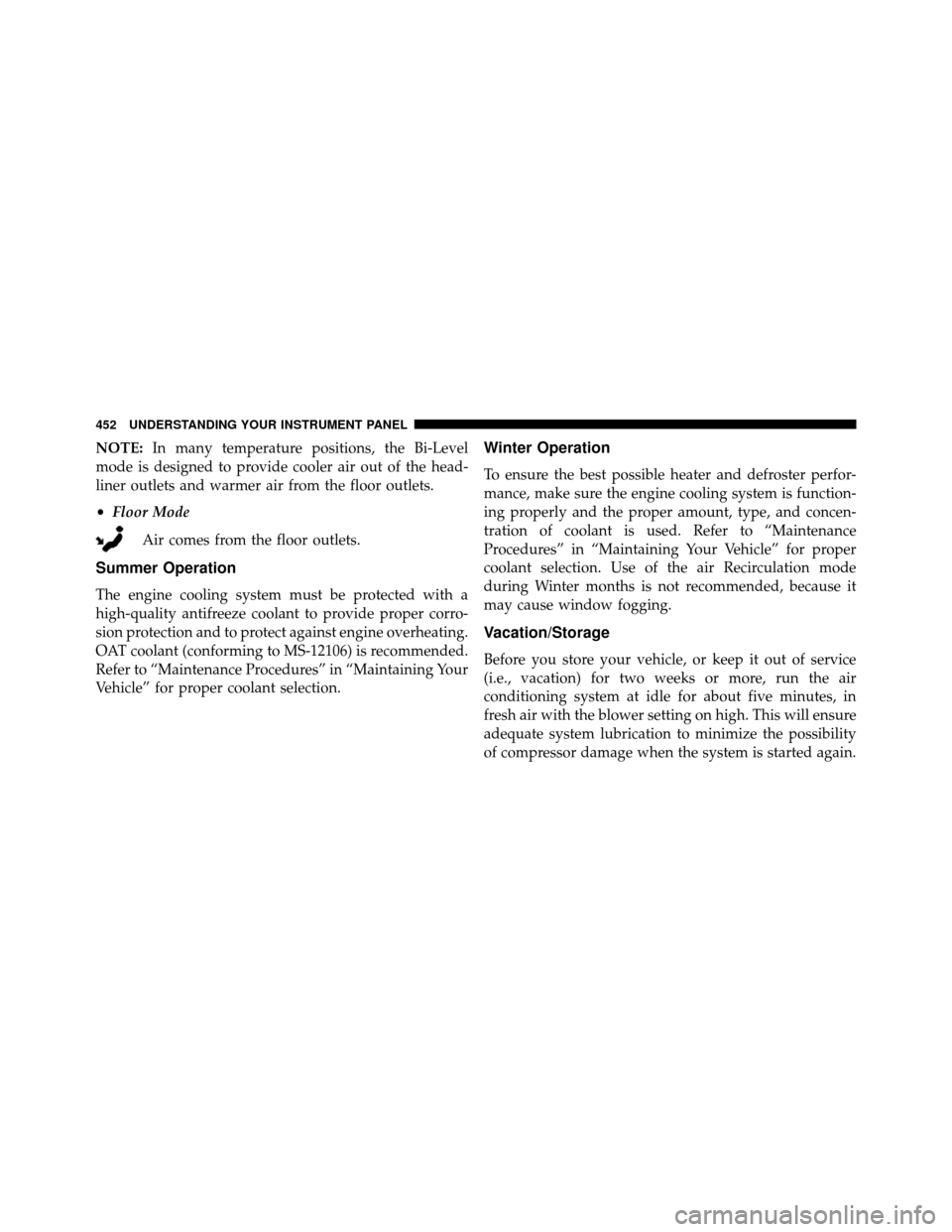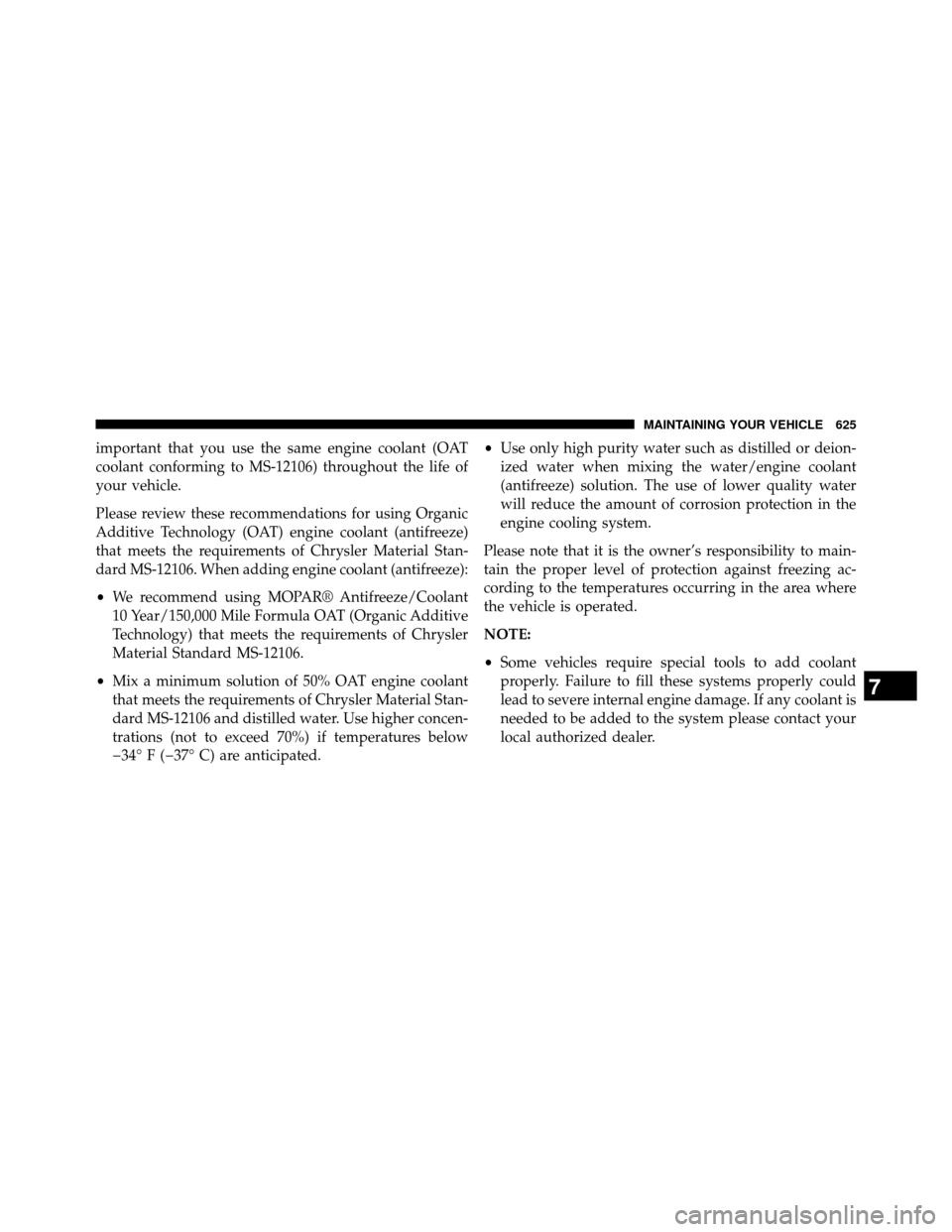2014 DODGE GRAND CARAVAN coolant level
[x] Cancel search: coolant levelPage 327 of 698

WARNING!
A hot engine cooling system is dangerous. You or
others could be badly burned by steam or boiling
coolant. You may want to call an authorized dealer
for service if your vehicle overheats. If you decide to
look under the hood yourself, see “Maintaining Your
Vehicle”. Follow the warnings under the Cooling
System Pressure Cap paragraph.
21. Low Fuel Light When the fuel level reaches approximately 2.0 gal
(7.8 L) this light will turn on, and remain on until
fuel is added.
22. Charging System Light
This light shows the status of the electrical charg-
ing system. The light should come on when the
ignition switch is first turned to ON/RUN and remain on briefly as a bulb check. If the light stays on or comes on
while driving, turn off some of the vehicle’s non-essential
electrical devices or increase engine speed (if at idle). If
the charging system light remains on, it means that the
vehicle is experiencing a problem with the charging
system. Obtain SERVICE IMMEDIATELY. See an autho-
rized dealer.
If jump starting is required, refer to “Jump Starting
Procedures” in “What To Do In Emergencies”.
23. Oil Pressure Warning Light
This light indicates low engine oil pressure. The
light should turn on momentarily when the engine is
started. If the light turns on while driving, stop the
vehicle and shut off the engine as soon as possible. A
chime will sound when this light turns on.
Do not operate the vehicle until the cause is corrected.
This light does not indicate how much oil is in the engine.
The engine oil level must be checked under the hood.
4
UNDERSTANDING YOUR INSTRUMENT PANEL 325
Page 454 of 698

NOTE:In many temperature positions, the Bi-Level
mode is designed to provide cooler air out of the head-
liner outlets and warmer air from the floor outlets.
• Floor Mode
Air comes from the floor outlets.
Summer Operation
The engine cooling system must be protected with a
high-quality antifreeze coolant to provide proper corro-
sion protection and to protect against engine overheating.
OAT coolant (conforming to MS-12106) is recommended.
Refer to “Maintenance Procedures” in “Maintaining Your
Vehicle” for proper coolant selection.
Winter Operation
To ensure the best possible heater and defroster perfor-
mance, make sure the engine cooling system is function-
ing properly and the proper amount, type, and concen-
tration of coolant is used. Refer to “Maintenance
Procedures” in “Maintaining Your Vehicle” for proper
coolant selection. Use of the air Recirculation mode
during Winter months is not recommended, because it
may cause window fogging.
Vacation/Storage
Before you store your vehicle, or keep it out of service
(i.e., vacation) for two weeks or more, run the air
conditioning system at idle for about five minutes, in
fresh air with the blower setting on high. This will ensure
adequate system lubrication to minimize the possibility
of compressor damage when the system is started again.
452 UNDERSTANDING YOUR INSTRUMENT PANEL
Page 627 of 698

important that you use the same engine coolant (OAT
coolant conforming to MS-12106) throughout the life of
your vehicle.
Please review these recommendations for using Organic
Additive Technology (OAT) engine coolant (antifreeze)
that meets the requirements of Chrysler Material Stan-
dard MS-12106. When adding engine coolant (antifreeze):
•We recommend using MOPAR® Antifreeze/Coolant
10 Year/150,000 Mile Formula OAT (Organic Additive
Technology) that meets the requirements of Chrysler
Material Standard MS-12106.
• Mix a minimum solution of 50% OAT engine coolant
that meets the requirements of Chrysler Material Stan-
dard MS-12106 and distilled water. Use higher concen-
trations (not to exceed 70%) if temperatures below
�34° F (�37° C) are anticipated. •
Use only high purity water such as distilled or deion-
ized water when mixing the water/engine coolant
(antifreeze) solution. The use of lower quality water
will reduce the amount of corrosion protection in the
engine cooling system.
Please note that it is the owner’s responsibility to main-
tain the proper level of protection against freezing ac-
cording to the temperatures occurring in the area where
the vehicle is operated.
NOTE:
• Some vehicles require special tools to add coolant
properly. Failure to fill these systems properly could
lead to severe internal engine damage. If any coolant is
needed to be added to the system please contact your
local authorized dealer.
7
MAINTAINING YOUR VEHICLE 625
Page 629 of 698

engine coolant in open containers or allow it to remain in
puddles on the ground. If ingested by a child or pet, seek
emergency assistance immediately. Clean up any ground
spills immediately.
Coolant Level
The coolant bottle provides a quick visual method for
determining that the coolant level is adequate. With the
engine OFF and cold, the level of the engine coolant
(antifreeze) in the bottle should be between the ranges
indicated on the bottle.
The radiator normally remains completely full, so there is
no need to remove the radiator/coolant pressure cap
unless checking for engine coolant (antifreeze) freeze
point or replacing coolant. Advise your service attendant
of this. As long as the engine operating temperature is
satisfactory, the coolant bottle need only be checked once
a month.
When additional engine coolant (antifreeze) is needed to
maintain the proper level, only OAT coolant that meets the
requirements of Chrysler Material Standard MS-12106
should be added to the coolant bottle. Do not overfill.
Points To Remember
NOTE:When the vehicle is stopped after a few miles/
kilometers of operation, you may observe vapor coming
from the front of the engine compartment. This is nor-
mally a result of moisture from rain, snow, or high
humidity accumulating on the radiator and being vapor-
ized when the thermostat opens, allowing hot engine
coolant (antifreeze) to enter the radiator.
If an examination of your engine compartment shows no
evidence of radiator or hose leaks, the vehicle may be
safely driven. The vapor will soon dissipate.
• Do not overfill the coolant expansion bottle.
7
MAINTAINING YOUR VEHICLE 627
Page 655 of 698

FLUID CAPACITIES
U.S.Metric
Fuel (Approximate) 20 Gallons76 Liters
Engine Oil with Filter
3.6L Engine (SAE 5W-20, API Certified). 6 Quarts5.6 Liters
Cooling System *
3.6L Engine (MOPAR® Antifreeze/Engine Coolant 10
Year/150,000 Mile Formula or equivalent) meeting the
requirements of Chrysler Material Standard MS-12106. 13.4 Quarts
12.6 Liters
* Includes heater and coolant recovery bottle filled to MAX level. Add 2.9 Qts (2.8 L) if equipped with a rear
heater.
7
MAINTAINING YOUR VEHICLE 653
Page 661 of 698

•Check tire pressure and look for unusual wear or
damage. Rotate tires at the first sign of irregular wear,
even if it occurs before the oil indicator system turns
on.
• Check the fluid levels of the coolant reservoir, brake
master cylinder, and power steering and fill as needed.
• Check function of all interior and exterior lights .
Required Maintenance Intervals .
Refer to the maintenance schedules on the following
page for the required maintenance intervals.At Every Oil Change Interval As Indicated By Oil Change Indicator System:
•Change oil and filter.
• Rotate the tires. Rotate at the first sign of irregu-
lar wear, even if it occurs before the oil indicator
system turns on.
• Inspect battery and clean and tighten terminals as
required.
• Inspect automatic transmission fluid if equipped
with dipstick.
• Inspect brake pads, shoes, rotors, drums, hoses
and park brake.
• Inspect engine cooling system protection and
hoses.
• Inspect exhaust system.
• Inspect engine air cleaner if using in dusty or
off-road conditions.
8
M
A I
N T
E
N
A
N
C E
S
C
H E
D
U L
E
SMAINTENANCE SCHEDULES 659
Page 679 of 698

Adding Fluid..........................631
Fluid and Filter Changes ..................632
Fluid Change ..........................632
Fluid Level Check .......................631
FluidType ............................630
Gear Ranges ...........................466
Special Additives .......................631
Torque Converter .......................474
Auto Up Power Windows ....................43
Battery .................................616
Jump Starting ..........................593
Keyless Transmitter Replacement (RKE) ........28
Saving Feature (Protection) ................231
Belts, Seat ...............................121
Body Mechanism Lubrication .................620
B-Pillar Location ..........................501
Brake Assist System .......................485
Brake Control System, Electronic ..............484Brake Fluid
.............................655
Brake System ............................628
Fluid Check ...........................629
Parking ..............................479
Warning Light .........................322
Brake/Transmission Interlock .................464
Bulb Replacement .........................649
Bulbs,Light.............................124
Calibration, Compass ......................342
Camera, Rear ............................254
Capacities, Fluid ..........................653
Caps, Filler Fuel .................................538
Power Steering .........................478
Radiator (Coolant Pressure) ................626
Carbon Monoxide Warning ..................120
Cargo Area Features .......................297
Cargo Compartment .......................297
10
INDEX 677
Page 681 of 698

Console, Overhead........................256
Console, Removable .......................294
Contract, Service ..........................669
Coolant Pressure Cap (Radiator Cap) ...........626
Cooling System ...........................622
Adding Coolant (Antifreeze) ...............624
Coolant Capacity .......................653
Coolant Level ..........................622
Disposal of Used Coolant .................626
Drain, Flush, and Refill ...................623
Inspection ............................627
Points to Remember .....................627
Pressure Cap ..........................626
Radiator Cap ..........................626
Selection of Coolant (Antifreeze) .............623
Corrosion Protection .......................632
Cupholders .............................279
Customer Assistance .......................667 Data Recorder, Event
.......................91
Daytime Running Lights ....................227
Dealer Service ............................609
Defroster, Windshield ......................122
Delay (Intermittent) Wipers ..................233
Diagnostic System, Onboard .................606
Dimmer Control ..........................228
Dipsticks Automatic Transmission ..................631
Oil (Engine) ...........................611
Power Steering .........................478
Disabled Vehicle Towing ....................600
Disposal Antifreeze (Engine Coolant) ................626
Door Locks Door Locks ............................35
KeyFob...............................35
Remote ...............................35
Remote Keyless Entry (RKE) ................35
10
INDEX 679